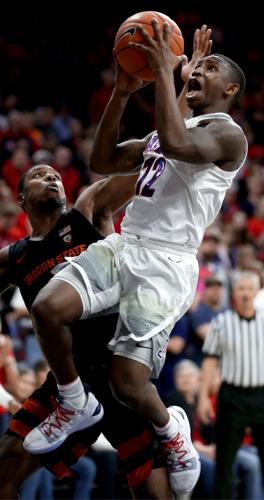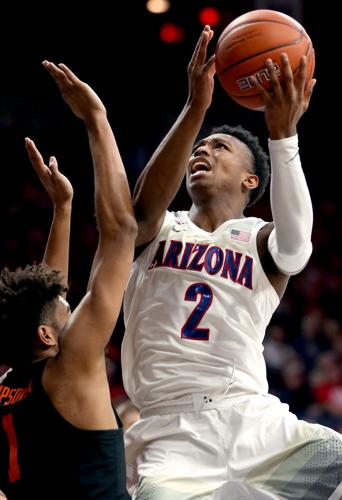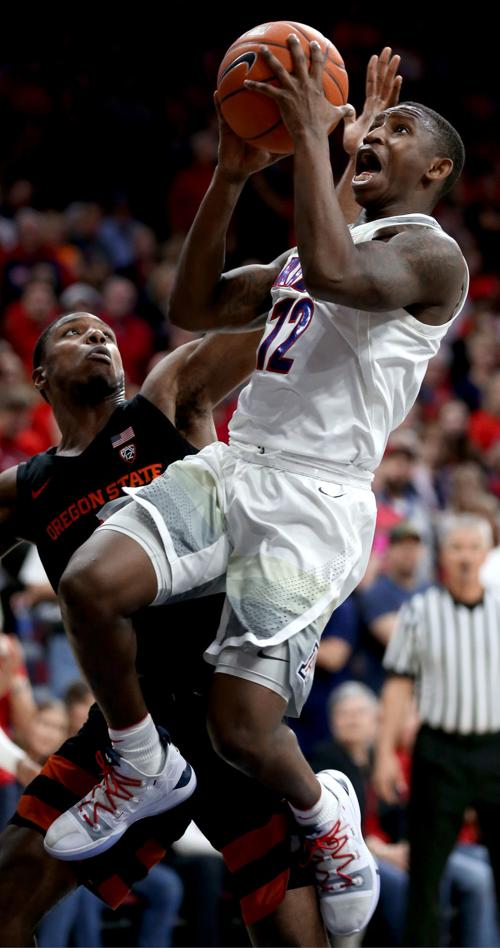There is a very clear reason Oregon State has gone 1-34 at McKale Center since 1983: Arizona has always had better players, and most of the time not a single Beaver could’ve started for the Wildcats.
Sometimes, it was close, like the McMiracle at McKale in 1986, when a 90-foot pass from Steve Kerr bounced into Craig McMillan’s hands for a 63-62 buzzer-beating win.
And once, in 2010, Sean Miller’s first season, it was debatable. The Beavers won in Tucson that season, but overall Arizona was the better club, finishing two games ahead of OSU in the league race.
Finally, on Saturday, for the first time since Arizona’s lineup included local players from Flowing Wells, Sahuaro and Cholla high schools — the Troy Cooke, David Haskins and Harvey Thompson team of 1983 — I looked across the court and thought I’d rather have Wayne Tinkle’s guys in the orange and black Oregon State jerseys.
Even Sean Miller might’ve agreed.
He said that the Thompson brothers, Stephen and Ethan, and Pac-12 player of the year candidate Tres Tinkle “may be the best group of three players we have in the Pac-12.
“As much as I’d like to say we did a good job on them, they combined for 49 points. They’re hard to stop.”
At one point in the first half, after Chase Jeter injured his back, Arizona deployed a lineup that included Jake DesJardins, Devonaire Doutrive and Alex Barcello. Nothing against those guys, but the Cooke-Thompson-Haskins rotation of ’83 was just as capable.
Just when it looked like the ceiling would cave in on Arizona’s size-challenged, depth-challenged, confidence-challenged club, the Wildcats did almost everything right and won 82-71.
Unlike the UA’s game plan Thursday, which was blown up by the Oregon Ducks’ defense, every X and every O that Miller and his staff put on paper worked so well that the Wildcats became a WOM — well-oiled machine.
“We played an inspired two hours of basketball,” said Miller. “We weren’t perfect but there’s nobody who can say we didn’t give it everything we had.”

Arizona guard Brandon Williams jostles his way over Oregon State’s Stephen Thompson Jr. for a bucket in the first half of their Pac-12 game at McKale Center, Saturday, Jan. 19, 2019.
It was a game of simple mathematics: Arizona attempted 67 shots and limited the Beavers to 49. No way you lose with those numbers.
How did that happen? Two things fell into place.
One, Ryan Luther played his best game since he played for Pitt in December of 2016. He went 8 for 8 from the field and grabbed seven rebounds against Rice that night.
And it wasn’t just automatic. With Jeter on the bench, Luther had to play a mix of center and power forward. He was superb, with 16 points and 11 rebounds. Talk about rising to the occasion.
“To his credit, it’s like an offensive lineman who plays guard and all of the sudden in the middle of the second quarter a couple of tackles go down,” said Miller. “There’s no other alternative but he’s got to play tackle.
“So Ryan not only played (center) but the played it seamlessly in our system. That was part of the reason we won tonight.”
Two, Justin Coleman, who is barely 5-feet 10-inches tall, was large and in charge. If Luther wasn’t the most important player on the court, Coleman was. Five steals. Five assists. Three 3s.
Coleman put on a clinic of running an offense — small ball — invading OSU’s interior defensive space without losing the ball, and then targeting open 3-point shooters like Brandon Williams and Dylan Smith.
Open? Arizona made 13 of 27 shots from 3-point range. That’s not just good, that’s one of the most rare statistics in the Sean Miller years.
Arizona has made more 3s in just one Pac-12 game since Miller arrived in Tucson, and that was a ridiculously easy 2016 victory over Stanford, in which Gabe York drilled nine 3s and even an end-of-the-bench player, Jacob Hazzard, swished three 3s in the last seven minutes of a 32-point victory.
There were no end-of-the-bench, garbage-time 3s on Saturday. All of 13 were game-changers.
“Today was our day,” said Coleman. “They fell.”
You don’t, however, get bonus points for beating Oregon State at home. If you are to contend with Washington, Oregon and Arizona State for the four coveted byes into the Pac-12 Tournament, you must not lose to the Beavers, even with your 7-foot center idle for the final 35 minutes.
You must take advantage of all your resources, such as the crowd at McKale Center. Saturday’s listed attendance of 14,410 is the largest of the season at McKale, and it was a factor. It was the first thing Miller mentioned in his post-game address.
“The (crowd) didn’t give up on us after losing a tough game Thursday,” he said. “Part of bouncing back is to feel like you’re supported, and especially here, you have that magical feeling in McKale. Trust me, everybody feeds off of it. I appreciate everybody from the Zona Zoo to those in the highest seats to those in the lowest.”
Arizona next enters the most difficult four-game patch of its conference schedule. Roadies at USC, UCLA and Arizona State, and a home game against league-leading Washington would be imposing for anyone.
The Wildcats not only will need Jeter healthy and playing at a high level, but also for Coleman and Luther to play with the fearlessness they displayed Saturday.
“If we don’t play well, any team on our schedule is capable of beating us,” said Miller. “But if we play well, we have a chance to win every game.”






